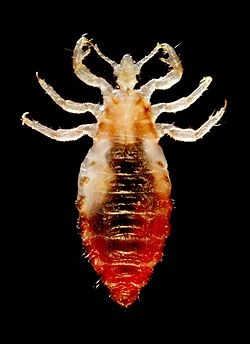Help for the Home Gardener from the Contra Costa Master Gardener Help Desk
Client's Problem:
(adult: actual size ~2-4mm)
CCMG Help Desk Analysis:
Under the office microscope we saw a mostly transparent, approximately 5mm insect with 6 legs with pincer ends. Legs and head were not moving. The center of the body had a sac of constantly moving dark red fluid (later identified as the client's blood). Review of our source material and confirmation with our entomologist identified the insect to be a body louse (Pediculus humanus humanus).
CCMG Help Desk Response to Client:
Well, we have some good news and some bad news. The good news is we identified the insect that has been biting you; the bad news is that it is body lice. The specimen you bought in is a body louse (Pediculus humanus humanus). Lice are very small flat bodied wingless insects (adults are 2-4mm long) that live exclusively off blood. Human body, head and pubic lice are also exclusively human parasites and cannot feed on any other animal. These insects are wingless and have legs adapted for crawling through hair or on clothing.
Although closely related to the head louse (quite common in elementary schools), the body louse differs in a number of significant ways:
- Body lice lay their eggs in clothing, cementing them to fibers.
- Adult and immature lice will shelter in the seams and folds of clothing worn for long periods, moving on to the host only to feed.
- The life cycle is 9 - 10 days from egg to adult, unless clothing is removed at night. Then complete development may take 2 - 4 weeks.
- These lice will die if clothing is not worn for several days.
- Body lice must feed every 24 hours, and if they cannot do so will quickly starve to death.
Body lice are spread through direct physical contact with a person who has body lice or through contact with articles such as clothing, beds, bed linens, or towels that have been in contact with an infested person. Body lice are usually only found in indigent people and particularly the homeless.
As far as treatment goes, you can check with your doctor, now that you know what's biting you. The doctor may have a prescription medication. For sure, all your clothing, bedding, and towels should be laundered using very hot water (at least 130°F) and machine dried using the hot cycle.
I am including several links that have additional information below:
http://www.cdc.gov/parasites/lice/body/index.html
http://www.calsurv.org/node/73
I hope this information helps you. This has obviously been quite a long and drawn out ordeal for you! Please let us know if you have any further questions.
Contra Costa Master Gardeners Help Desk
Editor's Note: The Contra Costa Master Gardener Help Desk is available year-round to answer your gardening questions. Except for a few holidays, we're open every week, Monday through Thursday from 9:00 am to Noon at 75 Santa Barbara Road, 2d Floor, Pleasant Hill, CA 94523.
We can also be reached via telephone: (925) 646-6586, email: ccmg@ucanr.edu, and we are on the web at http://ccmg.ucanr.edu/